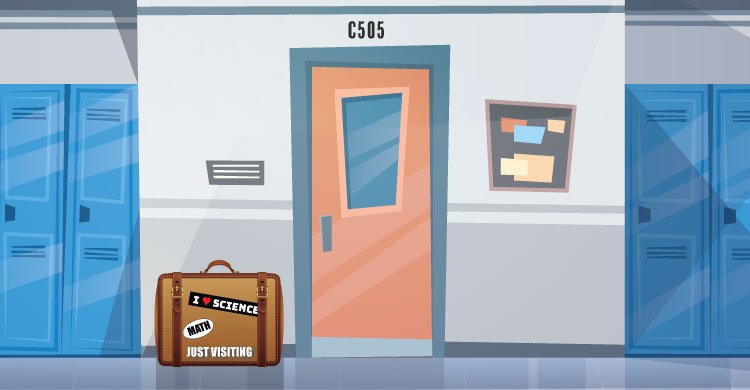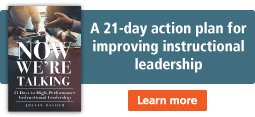This blog post is based on the book Now We’re Talking! 21 Days to High-Performance Instructional Leadership.
School leaders belong in classrooms on a regular basis. As I’ve promoted this belief around the country and online, I’ve rarely encountered anyone who believes otherwise.
Most administrators complete the formal teacher evaluations that are required by law or school policy, and most administrators seem to believe they get into classrooms informally on a fairly frequent basis.
I certainly thought I was in classrooms all the time. I believed, as a K–5 principal in Seattle Public Schools, that I spent a great deal of time in classrooms, supporting teachers and keeping my eyes open to information that would make me a more effective leader. But then I decided to collect data on my own practice—and I was stunned.
If you’d asked me, I would have reported visiting two to three classrooms a day. In reality, it was around three a week. Worse yet, many of those visits were to the same few teachers—teachers who were “easier” to visit in every way—higher-performing, friendlier, and located more conveniently in the building.
When I reviewed my records, I realized I’d avoided several classrooms entirely, for months on end. If I was going to be effective as a principal, I knew I needed to be in every classroom on a regular basis.
I was shocked to discover how rarely I visited classrooms, because class visits (or walkthroughs) were something I put a great deal of effort into. I designed forms, I collected evidence, I wrote feedback, and I kept records. Surely, with this degree of purposeful effort, I was making a difference, right?
Wrong. Only a handful of teachers saw me on a regular basis, and I had very little idea of what was going on in the rest of the school.
So I made a small change that made all the difference: I started keeping track of my visits and focused on frequency. I stopped worrying about whether I was giving the world’s best feedback and whether my observation template was perfect, and I started to focus on frequency.
The Magic Number
After some trial and error, I settled on a rhythm of three classroom visits per day.
Even if I decided to stay awhile, three visits didn’t take up so much of my time that they interfered with other obligations. And—since I supervised about thirty teachers—three visits per day got me around to every teacher every two weeks. Over the course of a 180-day school year, three visits per day add up to 540 visits in all. Subtracting a few days here and there for out-of-building meetings and other disruptions, three visits per day will put you in classrooms roughly five hundred times per year.
Depending on the size of your school, this may mean you visit each teacher weekly, biweekly, or somewhat less often. If you share teacher-evaluation duties with other administrators, I recommend you focus your visits on the teachers you supervise directly.
But what should you actually do when you drop by a classroom?
Keeping It Simple
Too often, we make our job harder than it needs to be. We know we need to spend time in classrooms, but we set the wrong goals for our visits, and as a result, we simply don’t make them happen.
For some reason, a rather complicated vision for “walkthroughs” has become popular in our profession. In the idealized walkthrough, the administrator observes briefly, collects some data, notes the strengths and weaknesses of the lesson or assessment, and provides feedback to help the teacher improve—all in the span of a few minutes.
It sounds easy, but it’s not—in fact, it’s virtually impossible.
While it might be possible to come up with helpful feedback for a novice teacher after a few minutes in the classroom, we’ll quickly run out of this low-hanging fruit. With more experienced teachers, a brief observation doesn’t usually give us enough information to confidently make a suggestion for improvement. We run the risk of insulting teachers, giving bad advice, or suggesting things they’ve already tried.
Deep down, we all know we can’t provide effective drive-by feedback. We know the idealized walkthrough doesn’t work. So we spend our time elsewhere and avoid visiting classrooms.
It’s a tragedy, because making high-impact classroom visits is actually quite simple. To help teachers grow, we just need to have a conversation—a conversation in which we ask the right questions and listen more than we talk. Visiting a classroom and talking with the teacher is much easier than crafting just-right feedback.
In fact, to get started, all we need to do is show up.
What to Do When You Visit #EveryClassroom
In Now We’re Talking! 21 Days to High-Performance Instructional Leadership, I share a robust model for having evidence-based conversations with teachers using the language of your instructional framework.
It’s more impactful than drive-by feedback, and it’s much easier to get right.
However, I don’t recommend starting with such a high bar. Instead, just get started. Over the course of the next week, simply visit every classroom. Make an appearance. Be “visible.”
In these quick first-round visits, just show up and enjoy the process. Don’t worry about providing feedback, collecting data, taking notes, or anything else. Simply be present for a few minutes. That’s it.
When we try to overcomplicate the process, reasons to avoid it come out of the woodwork. If I force myself to come up with the perfect feedback, I’ll draw a blank, and I’ll find an excuse not to visit. If I need an app and a rubric to get started, the app will crash, or I’ll find the rubric too cumbersome.
So ease into it. Start visiting classrooms, and challenge yourself to get into every classroom in the next few days.
As we enter the new school year, I’ve been encouraging school leaders to use the hashtag #EveryClassroom to share their commitment to visiting each teacher in the first week of school. If school has already started in your district, commit to visiting #EveryClassroom within the next week.
And when you do, let me know! Tweet at me @eduleadership, and I’ll cheer you on.
[author_bio id=”1144″]







